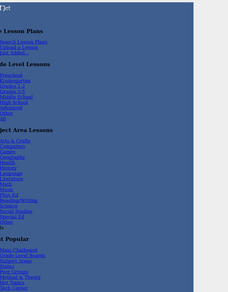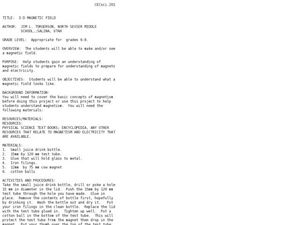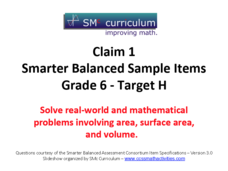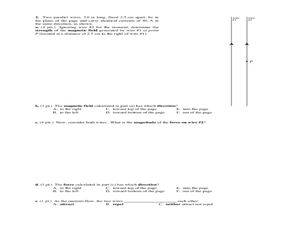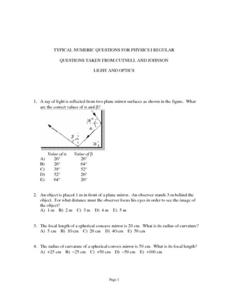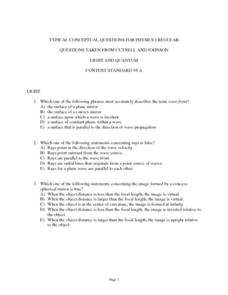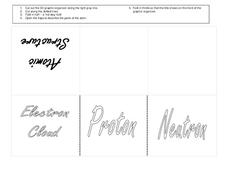West Contra Costa Unified School District
Connecting Graphing and Solving Absolute Value Equations and Functions
Can you solve an equation graphically? Absolutely! This Algebra II lesson makes the connection between solving an absolute value equation and graphing two functions. Graphing absolute value functions is presented through the process of...
Spectrum
Grade 5 Standardized Test Prep
Here you'll find a great sampling of practice standardized test questions organized into four sections: ELA, mathematics, social studies, and science. Help your learners become familiar with the types of multiple-choice questions...
Science Geek
Valence Electrons
There is a lot of negativity when studying electrons, but this presentation makes the experience more positive by beginning with the definition of a valence electron and breaking down the number of valence electrons by groups on the...
Curated OER
Nets
In this cube worksheet, learners work with nets of a cube and determine which net makes an cube. Students answer 7 questions.
Curated OER
Twister on Tuesday Chapter 10
In this comprehension worksheet, students read chapter 10 of the book Twister on Tuesday and complete 5 multiple choice questions. Answers are provided.
Curated OER
Teaching Correct Pronouns
I or me? Are your middle school grammarians struggling with pronoun case? Try this trick. Instruct your learners to look right before or right after the pronoun choice for the words and, or, nor. Have them cover the conjunction and the...
Curated OER
3-D Magnetic Field
Middle schoolers create a magnetic field. In this investigative lesson students design their own magnetic field so that they can see how magnetism and electricity work.
Curated OER
Making Words
In this word building activity, students cut out the given letters and create as many words as they can. Students record their words in the given column.
Curated OER
Making Words
In this word building worksheet, students cut out the given letters and create words. Students record the words into the columns.
CCSS Math Activities
Smarter Balanced Sample Items: 6th Grade Math – Target H
Knowing the surface area certainly helps when deciding how much paint to buy before a project. Scholars solve for surface area, as well as volume and area, as part of the presentation from Grade 6 Claim 1 Item Slide Shows. Geometric...
Curated OER
Toothpicks, Gumdrops, and Polyhedrons
Sixth graders use toothpicks and gumdrops to make prisms and pyramids. This helps them explore the relationship betweeen faces, vertices, and edges.
Pennsylvania Department of Education
Making Cubes
Third graders explore vocabulary associated with three dimensional figures. In this transformations lesson, 3rd graders create two dimensional nets for three dimensional figures. Students become familiar with describing two...
Curated OER
Guess My Shape
Learners play a game with shapes. They work in groups to identify the names and characteristics of various shapes. They give each other clues to see if others can identify the shape being described. This is a great hands on activity.
Houghton Mifflin Harcourt
Nature: Friend and Foe: English Language Development Lessons (Theme 6)
If readers don't understand key portions of a text, it may seem more like a foe than a friend. The second resource in a series of three ESL lessons designed to accompany the texts in Nature: Friend or Foe makes the texts easier to...
Curated OER
Third Grade Social Studies- Quiz
In this social studies worksheet, students complete a 25 question multiple choice quiz about early American colonial life and the Cherokee and other Native American tribes.
Curated OER
Economic Health Indicators: GDP and CPI Worksheet
Examine the nation's economic health using this GDP and CPI instructional activity, which features helpful graphic depictions of complex concepts. The first 2 pages include 17 short-answer questions intended to guide reading from a text...
Curated OER
Physics Midterm Exam #2
This comprehensive midterm exam covers a vast array of topics typical to high school physics curriculum. Problem solving and mutliple choice questions are incorporated. Review the exam to make sure that the content is suitable to your...
Arts & Humanities
Make Your Own Flower Garden
Get into art with a little instructional activity on flower parts. The class reviews basic information regarding flowers and then they use a paper mosaic technique to create visual representations of the lovely plants.
Curated OER
Typical Numeric Questions for Physics I - Electric Fields and Potential
Challenge your physics class to implement their knowledge of electric fields by completing this worksheet as homework. There are 15 problems to solve, for which pupils compute electrostatic force, electric field strength, and electric...
Curated OER
Typical Numeric Questions for Physics I - Light and Optics
Nineteen word problems dealing with frequency, speed, reflection, and refraction of light are provided here. Empower your physics masters to manipulate equations for computing angles, focal lengths, image heights, and more! This is a...
Curated OER
Typical Conceptual Questions for Physics I - Light and Quantum
This is a stellar overview of everything light and quantum! There are 30 multiple choice questions, none of them requiring any mathematical computation. There are a few diagrams to analyze: light rays striking reflective and refractive...
Curated OER
3D Computer Imaging Class: Cross-Section Lesson
Students use 3-dimensional materials to create a simple 3-D object. They think about different ways the object could be sliced. Students choose one way to slice the object, and draw the sliced shape on paper or computer. Using a 3-D...
Curated OER
The Atom
In this atom worksheet, learners complete a 3 D graphic organizer for the structure of the atom. They define atomic structure, electron cloud, proton and neutron. They cut out the terms to make flaps with definitions.
Curated OER
MAKING THREE DIMENSIONAL PLANT AND ANIMAL CELLS
Young scholars create two different cells, one plant and one animal. In this plant and animal cell instructional activity students form groups and construct a part of a cell. Young scholars then put them all together to form one...





